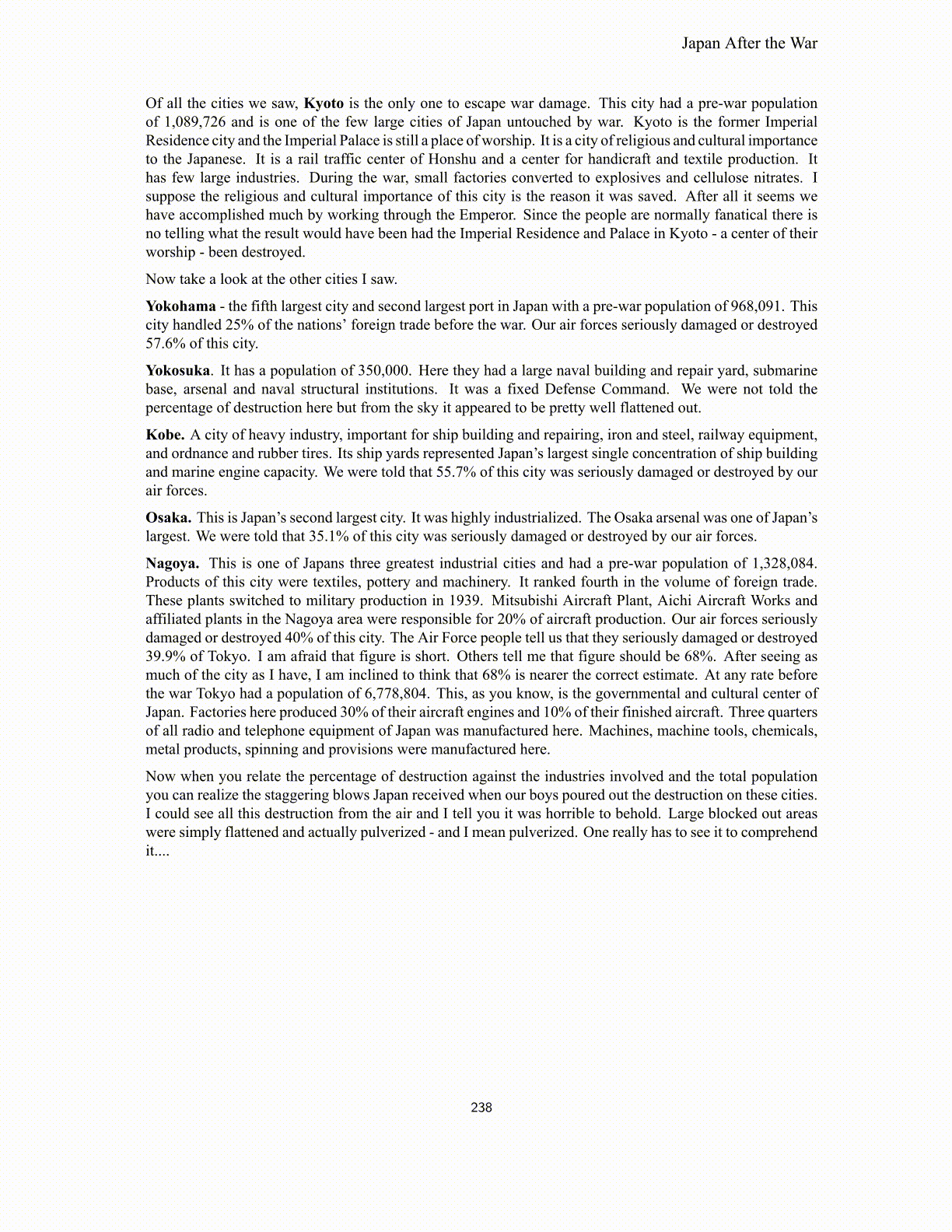
Japan After the War Of all the cities we saw, Kyoto is the only one to escape war damage. This city had a pre-war population of 1,089,726 and is one of the few large cities of Japan untouched by war. Kyoto is the former Imperial Residence city and the Imperial Palace is still a place of worship. It is a city of religious and cultural importance to the Japanese. It is a rail traffic center of Honshu and a center for handicraft and textile production. It has few large industries. During the war, small factories converted to explosives and cellulose nitrates. I suppose the religious and cultural importance of this city is the reason it was saved. After all it seems we have accomplished much by working through the Emperor. Since the people are normally fanatical there is no telling what the result would have been had the Imperial Residence and Palace in Kyoto - a center of their worship - been destroyed. Now take a look at the other cities I saw. Yokohama - the fifth largest city and second largest port in Japan with a pre-war population of 968,091. This city handled 25% of the nations’ foreign trade before the war. Our air forces seriously damaged or destroyed 57.6% of this city. Yokosuka . It has a population of 350,000. Here they had a large naval building and repair yard, submarine base, arsenal and naval structural institutions. It was a fixed Defense Command. We were not told the percentage of destruction here but from the sky it appeared to be pretty well flattened out. Kobe. A city of heavy industry, important for ship building and repairing, iron and steel, railway equipment, and ordnance and rubber tires. Its ship yards represented Japan’s largest single concentration of ship building and marine engine capacity. We were told that 55.7% of this city was seriously damaged or destroyed by our air forces. Osaka. This is Japan’s second largest city. It was highly industrialized. The Osaka arsenal was one of Japan’s largest. We were told that 35.1% of this city was seriously damaged or destroyed by our air forces. Nagoya. This is one of Japans three greatest industrial cities and had a pre-war population of 1,328,084. Products of this city were textiles, pottery and machinery. It ranked fourth in the volume of foreign trade. These plants switched to military production in 1939. Mitsubishi Aircraft Plant, Aichi Aircraft Works and affiliated plants in the Nagoya area were responsible for 20% of aircraft production. Our air forces seriously damaged or destroyed 40% of this city. The Air Force people tell us that they seriously damaged or destroyed 39.9% of Tokyo. I am afraid that figure is short. Others tell me that figure should be 68%. After seeing as much of the city as I have, I am inclined to think that 68% is nearer the correct estimate. At any rate before the war Tokyo had a population of 6,778,804. This, as you know, is the governmental and cultural center of Japan. Factories here produced 30% of their aircraft engines and 10% of their finished aircraft. Three quarters of all radio and telephone equipment of Japan was manufactured here. Machines, machine tools, chemicals, metal products, spinning and provisions were manufactured here. Now when you relate the percentage of destruction against the industries involved and the total population you can realize the staggering blows Japan received when our boys poured out the destruction on these cities. I could see all this destruction from the air and I tell you it was horrible to behold. Large blocked out areas were simply flattened and actually pulverized - and I mean pulverized. One really has to see it to comprehend it.... 238